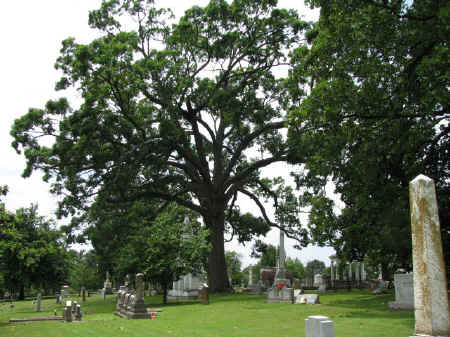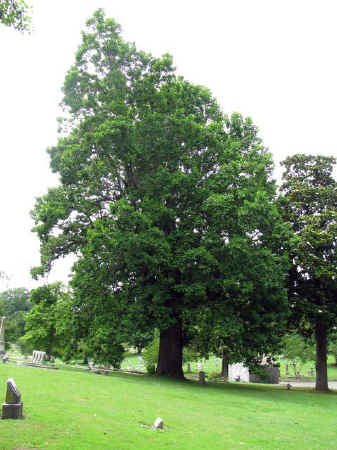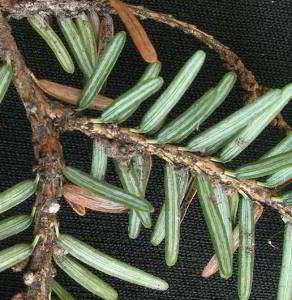|
==============================================================================
TOPIC: Trip to Memphis TN
http://groups.google.com/group/entstrees/browse_thread/thread/6372b1988264d202?hl=en
==============================================================================
== 1 of 1 ==
Date: Fri, May 30 2008 8:01 am
From: Beth Koebel
ENTS,
My trip to Memphis, TN, home of the blues, BBQ, and
Elvis, started when Mary posted an email asking for
someone to get in contact with Linley Schmidt of
Elmwood Cemetery. I said I could go since I am about
300 miles from there and have always wanted to go.
After a few emails to Linley I was ready to go. I was
on the road about 3:30 to 4:00am on Wednesday, May
28,2008. Map quest said it was a little longer than a
4hour trip and I had to get gas, money, and stop for
breakfast so I figured I would get there right around
8:45 to 9:00am, the time of my appointment. I got
there early about 8:15 to 8:30am so I drove around the
cemetery but I didn't really noticed any trees of
size. It was one of those cloudy, drizzly days.

Northern Red Oak
I met Linley and we began to walk around the cemetery
and I realized why I didn't see trees of great size.
We were walking on the left side of the cemetery and I
drove on the right side of the cemetery. The first
tree that we walked to was a beautiful Northern Red
Oak (Quercus rubra). I got all my tools out, laser
range finder, inclinometer, gps unit, camera, paper,
and pen. I noticed that the gps units batteries where
dead. Why I don't know because I just replaced them a
month ago. As Linley was nice enough to go back to
the office, a cottage that was built in 1862-1866 and
remolded in 1978, to get me some new batteries. I went
ahead and measured the tree. I went to take a photo
of the tree and found that despite charging all night
long before I left the battery in my camera was dead!
So much for photos :( I explained to Linley about the
sine-sine method of measuring tree heights and how
accurate that it is. I think I lost her as soon as I
mentioned Trig. She had already measured these trees
using the tangent method (stick).

Atlas Cedar
We then walked to the right side of the cemetery to
measure the Atlas Cedar (Cedrus atlanica). Walking up
to it it reminded of a green-blue waterfall. I didn't
notice this before because I didn't know what kind of
tree it was. For those of you like me who don't know
anything about Atlas Cedars here is a link
http://en.wikipedia.org/wiki/Atlas_Cedar
We then started walking across to the left side of the
cemetery when we walked by the "Tsuga". See other
post.
We walked on to the hackberry (Celtis occientalis).
Once under her you can tell that she had lost a major
branch that included the former topmost branch as she
now measured 20 feet less in height. We concluded
this after I measured the height of the tree twice and
my measurements were with in 1.5 feet of each other.
Despite this the tree was a magnificent example of a
hackberry.

Tuliptree
Linley had one more tree for me to measure and this
was the tulip tree (Liriodendron tulipfera). As we
walked up to the tree I noticed another tree of good
size. As we walked up the the tulip tree one can tell
that the tree as lost it main top. Linley told me
that it got hit by lighting. Sadly this tree is
damaged by the lighting strike to the point that it
will die from it. It is been hollowed out from where
the main trunk broke off all the way to the ground.
Once again I measured the tree twice as the height
that I got the first time was considerably less than
what she had. Once again my measurements were 1.5
different from each other.
The other tree of good size that I noticed was a water
oak (Quercus nigra). This tree is good shape and was
wonderful just seeing her with her spreading branches
providing shade. The tree had a round to a semi-round
crown on it.
It makes me sad to think that I wasn't able to take
any photos especially of the oaks as they are my
favorite trees.
Q. rubra
CBH 190.5"
H 90.468'
Ave. Crown 115'
Total Points(AF) 309.72
C. atlantica
CBH 135"
H 46.97'
Ave. Crown 65.5'
Total Points(AF) 198.35
C. occientalis
CBH 175"
H 68.7'
Ave. Crown 83.5'
Total Points(AF) 264.58
L. tulipfera
CBH 208"
H 91.84'
Ave. Crown 77.5'
Total Points(AF) 319.21
Q. nigra
CBH 226"
H 101.79'
Ave. Crown 127'
Total Points(AF) 359.54
Beth
"Information is moving--you know, nightly news is one way, of
course, but it's also moving through the blogosphere and through the
Internets."
Washington DC, May 2, 2007 George W. Bush
==============================================================================
TOPIC: photos of Elmwood Cemetery
http://groups.google.com/group/entstrees/browse_thread/thread/8ad8340e112f3817?hl=en
==============================================================================
== 1 of 1 ==
Date: Fri, May 30 2008 2:39 pm
From: Beth Koebel
ENTS,
Since my camera was down during my trip to Elmwood
Cemetery in Memphis, TN Linley Schmidt sent me some
pics and I have downloaded them. The pics are of the
northern red oak, atlas cedar, and tulip tree.
[Incorporated in Post Above]
Beth
==============================================================================
TOPIC: Hemlock Sighting
http://groups.google.com/group/entstrees/browse_thread/thread/fcf9798c72777c4a?hl=en
==============================================================================
== 1 of 3 ==
Date: Thurs, May 29 2008 7:02 pm
From: Beth
ENTs,
While I was walking around Elmwood Cemetery with Linley Schimdt (I
will send another email about my trip there) anevergreen tree caught
my eye because of the poor shape it was in. The top had been blown
out and part of what remained was dead. I would never have walked by
it if it wasn't on our way to one of the tree to measure. On the
sign
that was posted on the tree said "Tgusa"! Now weather it
is an
Eastern or a Carolina Hemlock I do not know. I told Linley about the
dismile outlook for these species in their native habitat and she
told
me that the Director of the Cemetery wants to cut it down. She now
has a reason to try to get the director to change her mind. She also
said that they would be glad to try and grow more "Tgusa".
I did not
notice any HWA as one would expect being out of its normal range.
Beth
== 2 of 3 ==
Date: Thurs, May 29 2008 9:33 pm
From: "Edward Frank"
Beth,
Where is Elwood Cemetery? The two major species found in the east
are Caroliniana and Canadiensis. Both have flattened needles. In
eastern hemlock they are arranged in two rows essentially in a flat
plane on the twig. In Carolina hemlock the needles splay outward in
different directions. It is possible that you may have a species of
western Tsuga also.
Ed
Carolina Hemlock:
Trees to 30 m tall, up to 150 cm dbh. Crown conic, flattening in old
trees; first-order branches long, slender, spreading horizontally.
Bark smooth, red-brown with yellow resin blisters, with age becoming
rough, scaly and fissured, with purple-grey outer bark and red-brown
inner bark. Twigs light brown, smooth or finely grooved, thinly
covered with short, dark hairs. Vegetative buds oblong, 3-4 mm.
Leaves 10-20 mm, mostly spreading in all directions from twigs, flat
but slightly revolute; abaxial surface glaucous, with 2 broad,
conspicuous stomatal bands, adaxial surface shiny green; margins
entire. Seed cones ovoid to oblong, 2.5-4 ? 1.5-2.5 cm; scales
oblong, 12-18 ? 8-12 mm, bases clawed, apex rounded. 2n=24 (Farjon
1990, Taylor 1993). Pollination occurs from March to the end of
April. The cones ripen from late August to late September of the
next year; the seed is dispersed from September through the winter
(USDA 2005).

Carolina Hemlock
Eastern Hemlock
Trees to 30 m; trunk to 150 cm dbh; crown broadly conic. Bark
brownish, scaly and fissured. Twigs yellow-brown, densely pubescent.
Buds ovoid, 1.5-2.5 mm. Leaves (5)15-20(25) mm, mostly appearing
2-ranked, flattened; abaxial surface glaucous, with 2 broad,
conspicuous stomatal bands, adaxial surface shiny green
(yellow-green); margins minutely dentate, especially toward apex.
Seed cones ovoid, 1.5-2.5 ? 1-1.5 cm; scales ovate to cuneate, 8-12
? 7-10 mm, apex ? round, often projected outward. 2n=24 (Taylor
1993).

Canadien hemlock (underside view)
== 3 of 3 ==
Date: Fri, May 30 2008 2:02 am
From: Beth
Ed,
Elmwood Cemetery is in Memphis TN. I could not see the needles that
close as they were about 20 feet up.
Beth
==============================================================================
TOPIC: Trip to Memphis TN
http://groups.google.com/group/entstrees/browse_thread/thread/6372b1988264d202?hl=en
==============================================================================
== 1 of 2 ==
Date: Sat, May 31 2008 1:42 pm
From: "Will Blozan"
Beth,
Based on my limited experience in the Memphis area I'm surprised
those trees
are so short! Can you post the "stick" heights for
comparison?
Will
== 2 of 2 ==
Date: Sat, May 31 2008 3:50 pm
From: Beth Koebel
Will,
I don't have the stick measurements Linley Schmidt had
those. I know that except for the Tulip Tree and the
Hackberry I was fairly close to what she had before.
The Hackberry had lost its main lead and thus lost
height. The tulip tree was about 30 feet(?) shorter
hince the reason to measure it twice. It sits on a
hill and maybe that threw off the stick measurement.
Beth
|